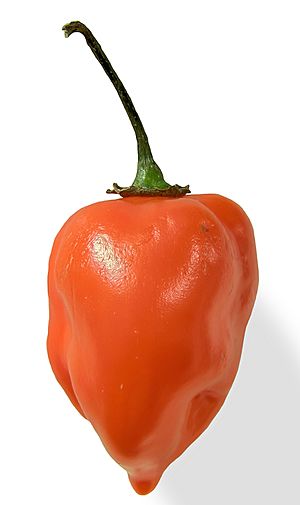Habanero chili facts for kids
Quick facts for kids Habanero |
|
|---|---|

A habanero chili
|
|
| Species | Capsicum chinense |
| Cultivar | 'Habanero' |
The habanero chili is a very popular and super spicy type of chili pepper. When they are young, habaneros are green. As they grow, they change color to bright orange or red. You might also see them in white, brown, or even pink! A ripe habanero is usually about 2–6 centimetres (0.8–2.4 in) long. These little peppers are known for being extremely hot, scoring between 100,000 and 350,000 on the Scoville scale.
The habanero chili originally comes from the Amazonas region. From there, it traveled and became very popular in Mexico. The habanero plant is a perennial flowering plant. This means it can grow flowers and fruit for many years if it's taken care of well.
Contents
Habanero History and Where It Grows
The habanero chili first grew in the Amazon rainforest. From there, it spread to other places, especially Mexico. Scientists found an old habanero plant in Peru that was about 8,500 years old! Another whole habanero fruit, found in a cave in Peru, was dated to 6500 BC.
Spanish explorers helped spread the habanero chili to other parts of the world. In the 1700s, some scientists even thought it came from China. That's why its scientific name, Capsicum chinense, means "the Chinese pepper."
Today, the biggest producer of habaneros is the Yucatán Peninsula in Mexico. Habaneros are a huge part of the food there. People eat them with almost every meal, either fresh, as a puree, or in a salsa. Other countries that grow a lot of habaneros include Belize, Panama, Costa Rica, Colombia, and Ecuador. You can also find them growing in parts of the United States, like Texas and California.
Habanero vs. Scotch Bonnet
The Scotch bonnet pepper is often compared to the habanero. This is because they are both types of the same plant species. However, they look a bit different. Both the Scotch bonnet and the habanero have thin, waxy skin. They also have a similar level of spiciness and taste. The exact spiciness can change a lot from one pepper to another. This depends on the plant's genes, how it was grown, the weather, and if the plant was stressed.
World's Hottest Chili Peppers
In 1999, the habanero was listed in Guinness World Records as the world's hottest chili. But since then, other peppers have taken its place. Peppers like the Bhut jolokia (also called the ghost pepper) and the Trinidad Moruga scorpion are even hotter. These are also types of the Capsicum chinense species.
Plant breeders are always trying to create new types of peppers. They cross different peppers to make even hotter ones. Their goal is to break the record on the Scoville scale. One example is the Carolina Reaper. This super hot pepper was made by crossing a Bhut jolokia with a very spicy red habanero.
Growing Habanero Plants
Habaneros love hot weather. Like all peppers, habanero plants grow best in a spot that gets plenty of morning sun. They also prefer soil that is slightly acidic, with a pH level around 5 to 6.
Watering Your Habaneros
How you water habaneros can affect their spiciness. If you water them every day, the plants will grow bigger leaves. However, they will produce the same number of fruits, and these fruits might be less spicy. It's better to water them only when the soil feels dry, which might be about once a week. If the soil and roots get too wet, the peppers might taste bitter.
Watering daily when the plant is flowering and starting to grow fruit can help stop flowers and young fruits from falling off. But even in perfect conditions, many flowers can still drop off.
Habanero Life Cycle
The habanero is a perennial flowering plant. This means that if you take good care of it and the conditions are right, it can produce flowers and fruit for many years. Habanero bushes are great for growing in a container garden.
In places with cold winters, habaneros are usually grown as annuals. This means they die each winter and new plants are grown the next spring. But in tropical and subtropical areas, habaneros can produce fruit all year long. As long as the weather is good, the plant will keep making peppers!
Images for kids
-
Belizean red habaneros being prepared for washing, sorting and grinding
-
Habanero hot sauce from Flor de Lirio, an Indigenous cooperative in Peto Municipality, Yucatán













